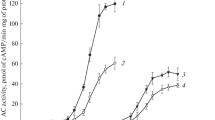Abstract
Hormonally responsive adenylyl cyclases are membrane-bound enzyme systems which consist of at least five distinct components: receptors for stimulatory and inhibitory hormones; transducing proteins called Gs and Gi, respectively, which mediate the effects of hormone-occupied receptor and function in a guanine nucleotide- and Mg ion-dependent fashion; and a catalytic component, which produces cAMP (for review on the component nature of adenylyl cyclases, see 1). Previous studies from our laboratory indicate that rabbit corpora lutea contain an adenylyl cyclase system that, in addition to being stimulated by gonadotropin and catecholamines (2,3), is attenuated by guanine nucleotides and enkephalin (4,5) suggesting the presence of Gi. As first demonstrated by Katada and Ui (6,7), one method to substantiate the existence of Gi in a given tissue is to treat the tissue with pertussis toxin and a [P]NAD, demonstrate the [P] ADP-ribosylation of a membrane protein with an Mr of 40–41,000 daltons and show that this treatment uncouples inhibitory receptors linked to adenylyl cyclase. In this study we present such data establishing the existence of Gi in the rabbit corpus luteum.
Access this chapter
Tax calculation will be finalised at checkout
Purchases are for personal use only
Preview
Unable to display preview. Download preview PDF.
Similar content being viewed by others
References
Birnbaumer L, Codina J, Mattera R. Regulation of hormone receptors and adenylyl cyclases by guanine nucleotide binding N proteins. Recent Prog Horm Res 1985; 41:41–99.
Birnbaumer L, Yang PC, Hunzicker-Dunn M, Bockaert J, Duran JM. Adenylyl cyclase activities in ovarian tissues. I. Homogenization and conditions of assay in Graffian follicles and corpora lutea of rabbits, rats, and pigs: regulation by ATP and some comparative properties. Endocrinology 1976; 99:163–84.
Abramowitz J, Birnbaumer L. Properties of the hormonally responsive rabbit luteal adenylyl cyclase: effects of guanine nucleotides and magnesium ion on stimulation by gonadotropin and catecholamines. Endocrinology 1982; 110:773–81.
Abramowitz J, Campbell AR. Enkephalin-mediated inhibition of forskolin-stimulated rabbit luteal adenylyl cyclase activity. Biochem Biophys Res Commun 1983; 116:574–80.
Abramowitz J, Campbell AR. Effects of guanine nucleotides and divalent cations on forskolin activation of rabbit luteal adenylyl cyclase: evidence for the existence of an inhibitory guanine nucleotide-binding regulatory component. Endocrinology 1984; 114:1955–62.
Katada T, Ui M. Islet-activating protein. A modifier of receptor-mediated regulation of rat islet adenylate cyclase. J Biol Chem 1981; 256:8310–7.
Katada T, Ui M. Direct modification of the membrane adenylate cyclase system by islet-activating protein due to ADP-ribosylation of a membrane protein. Proc Natl Acad Sci USA 1982; 79:3129–33.
Abramowitz J, Campbell AR. Cholera toxin action on rabbit corpus luteum membranes: effects on adenylyl cyclase activity and adenosine diphospho-ribosylation of the stimulatory guanine nucleotide-binding regulatory component. Biol Reprod 1985; 32:463–74.
Bokoch GM, Katada T, Northup JK, Ui M, Gilman AG. Purification and properties of the inhibitory guanine nucleotide-binding regulatory component of adenylate cyclase. J Biol Chem 1984; 259:3560–7.
Codina J, Hildebrandt J, Sekura RD. Ns and Ni, the stimulatory and inhibitory regulatory components of adenylyl cyclases. Purification of the human erythrocyte proteins without the use of activating regulatory ligands. J Biol Chem 1984; 259:5871–86.
Gilman AG. G proteins: transducers of receptor-generated signals. Annu Rev Biochem 1987;56:615–49.
Tsai SC, Adamik R, Kanaho Y, Hewlett EL, Moss J. Effects on guanine nucleotides and rhodopsin on ADP-ribosylation of the inhibitory GTP-binding component of adenylate cyclase by pertussis toxin. J Biol Chem 1984; 259:15320–3.
Lim LK, Sekura RD, Kaslow HR. Adenine nucleotides directly stimulate pertussis toxin. J Biol Chem 1985; 260:2585–8.
Mattera R, Codina J, Sekura RD, Birnbaumer L. The interaction of nucleotides with pertussis toxin. Direct evidence for a nucleotide binding site on the toxin regulating the rate of ADP-ribosylation of Ni, the inhibitory regulatory component of adenylyl cyclase. J Biol Chem 1986; 261:11173–9.
Burns DL, Manclark CR. Adenine nucleotides promote dissociation of pertussis toxin subunits. J Biol Chem 1986; 261:4324–7.
Hildebrandt JD, Sekura RD, Codina J, Iyengar R, Manclark CR, Birnbaumer L. Stimulation and inhibition of adenylyl cyclases mediated by distinct regulatory proteins. Nature 1983; 302:706–9.
Cote TE, Frey EA, Sekura RD. Altered activity of the inhibitory guanyl nucleotide-binding component (Ni) induced by pertussis toxin. Uncoupling of Ni from receptor with continued coupling of Ni to the catalytic unit. J Biol Chem 1984; 259;8693–8.
Tsong SD, Phillips DM, Halmi N, Kreiger DT, Bardin CW. ß-Endorphin is present in the male reproductive tract of five species. Biol Reprod 1982; 27:755–64.
Shaha C, Margioris A, Liotta AS, Kreiger DT, Bardin CW. Demonstration of immunoreactive β-endorphin- and α3-melanocyte-stimulating hormone-related peptides in the ovaries of neonatal, cyclic and pregnant mice. Endocrinology 1984; 115:378–84.
Kilpatrick DL, Rosenthal JL. The proenkephalin gene is widely expressed within the male and female reproductive systems of the rat and hamster. Endocrinology 1986; 119:370–4.
Meiner MH, Young SL, Czerwiec FS, et al. The regulation of granulosa cell proopiomelanocortin messenger ribonucleic acid by androgens and gonadotropins. Endocrinology 1986; 119:2082–8.
Author information
Authors and Affiliations
Editor information
Editors and Affiliations
Rights and permissions
Copyright information
© 1989 Plenum Press, New York
About this chapter
Cite this chapter
Abramowitz, J., Jena, B.P. (1989). Pertussis Toxin Uncouples Enkephalin-Mediated Inhibition of Rabbit Luteal Adenylyl Cyclase. In: Hirshfield, A.N. (eds) Growth Factors and the Ovary. Springer, Boston, MA. https://doi.org/10.1007/978-1-4684-5688-2_51
Download citation
DOI: https://doi.org/10.1007/978-1-4684-5688-2_51
Publisher Name: Springer, Boston, MA
Print ISBN: 978-1-4684-5690-5
Online ISBN: 978-1-4684-5688-2
eBook Packages: Springer Book Archive



